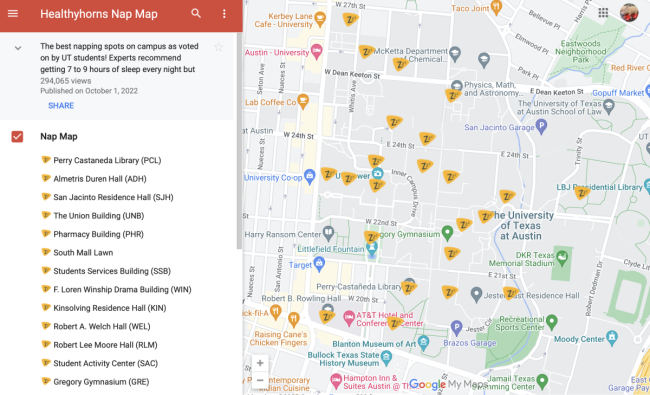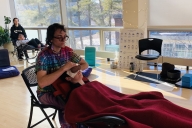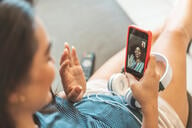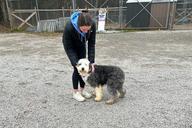You have /5 articles left.
Sign up for a free account or log in.

The University of Texas at Austin’s nap map
University of Texas at Austin
At least half of college students aren’t getting sufficient sleep, even though many students report that this impacts their academic performance—in addition to their overall well-being.
Seeking to help students supplement the recommended seven to nine hours of sleep per night, numerous institutions have developed what they are calling nap maps.
Among them is the University of Texas at Austin, whose public-health-oriented Longhorn Wellness Center maintains the map. The premise: when students get tired between classes or activities but can’t easily go home to rest, they should be able to take a quick nap somewhere on campus. College students, of course, have long catnapped in campus libraries and elsewhere, but nap maps are intended to legitimize the practice.
Best rest tips: The Longhorn Wellness Center—which also runs a Sleep Week awareness campaign each fall, and which offers students sleep kits throughout the year (think eye masks and earplugs)—recommends that campus naps last between 20 and 30 minutes. Ideally, students nap between the hours of 1 and 4 p.m., so as not to disrupt sleep later on.
Highlighted napping spots aren’t solely designated for this purpose, so students should expect campus life to carry on around them. Campus nappers also are advised to use their backpacks as a pillow and keep valuables secure and out of sight.
Site scoring: Nap map locations are vetted for appropriateness and comfort. UT Austin, for instance, relies on student volunteers to help update its map about once a year and to rate locations on a one-to-five scale on the following:
- Accessibility
- Comfort
- Crowd activity
- Noise
UT Austin’s map currently includes about 20 indoor and outdoor locations, from Turtle Pond to the Life Science Library. Location hours, where applicable, are listed.
Napping options are key, says Brittany O’Malley, assistant director for prevention at the Longhorn Wellness Center. “So many of our students have such different rhythms and routines, depending on their major, their school or the college they’re in. So there are some students who would look at this list and say, ‘I don’t even know where that [location] is.’ And then others would say, ‘Yes, that’s exactly true.’ It’s such a big campus that we’re on that this map gives options for everyone.”
The sleep/success connection: O’Malley emphasizes that napping is only one piece of students’ sleep hygiene, and that sleep is crucial to their success.
“Student success is about your ability not just to function but to thrive. And we know that sleep is so important, not just for our physical health but for our ability to think and make critical decisions and be emotionally healthy.”
Building sleep awareness and hygiene is about meeting students where they are and helping them understand not only the consequences of poor sleep but the benefits of good rest, O’Malley adds.
“In our sleep workshops, we’ll ask students, ‘How do you feel when you get a good night’s sleep? How do you feel when you’re in a rhythm with your sleep?’ And their answers are exactly what we describe as students’ success: ‘I feel energetic. I feel like I can focus better. I feel like I can ace the test. I feel like I can be a better friend or partner to someone.’”





